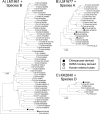Detection and genetic characterization of enteroviruses circulating among wild populations of chimpanzees in Cameroon: relationship with human and simian enteroviruses
- PMID: 21345956
- PMCID: PMC3126250
- DOI: 10.1128/JVI.02285-10
Detection and genetic characterization of enteroviruses circulating among wild populations of chimpanzees in Cameroon: relationship with human and simian enteroviruses
Abstract
Enteroviruses (EVs), members of the family Picornaviridae, are a genetically and antigenically diverse range of viruses causing acute infections in humans and several Old World monkey (OWM) species. Despite their known wide distribution in primates, nothing is currently known about the occurrence, frequency, and genetic diversity of enteroviruses infecting apes. To investigate this, 27 chimpanzee and 27 gorilla fecal samples collected from undisturbed jungle areas with minimal human contact in Cameroon were screened for EVs. Four chimpanzee samples were positive, but none of the gorilla samples were positive. Genetic characterization of the VP1, VP4, and partial VP2 genes, the 5' untranslated region, and partial 3Dpol sequences enabled chimpanzee-derived EVs to be identified as (i) the species A type, EV76, (ii) a new species D type assigned as EV111, along with a human isolate from the Democratic Republic of Congo previously described by the International Committee on the Taxonomy of Viruses, and (iii) a new species B type (assigned as EV110) most closely related to, although a distinct type from, the SA5 isolate recovered from a vervet monkey. The identification of EVs infecting chimpanzees related to those circulating in human and OWM populations provides evidence for cross-species transmission of EVs between primates. However, the direction of transfer and the existence of primate sources of zoonotic enterovirus infections in humans require further investigation of population exposure and more extensive characterization of EVs circulating in wild ape populations.
Figures




References
-
- Bailes E., et al. 2003. Hybrid origin of SIV in chimpanzees. Science 300:1713. - PubMed
-
- Bingjun T., et al. 2008. Molecular typing and epidemiology of non-polio enteroviruses isolated from Yunnan Province, the People's Republic of China. J. Med. Virol. 80:670–679 - PubMed
-
- Brown D. W. 1997. Threat to humans from virus infections of non-human primates. Rev. Med. Virol. 7:239–246 - PubMed
Publication types
MeSH terms
Substances
Associated data
- Actions
- Actions
- Actions
- Actions
- Actions
- Actions
- Actions
- Actions
- Actions
- Actions
- Actions
- Actions
Grants and funding
LinkOut - more resources
Full Text Sources
Research Materials
Miscellaneous

